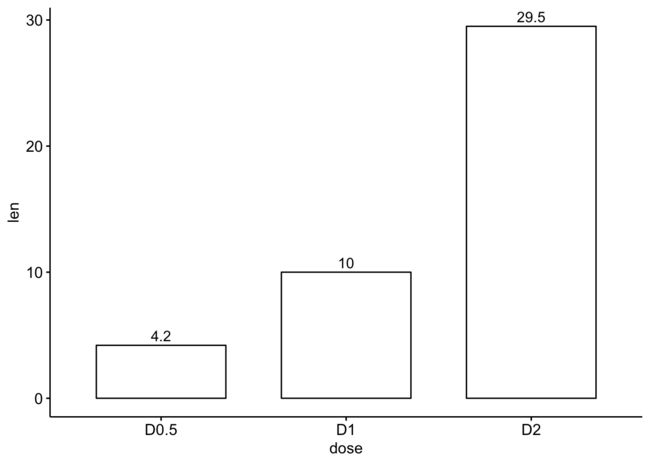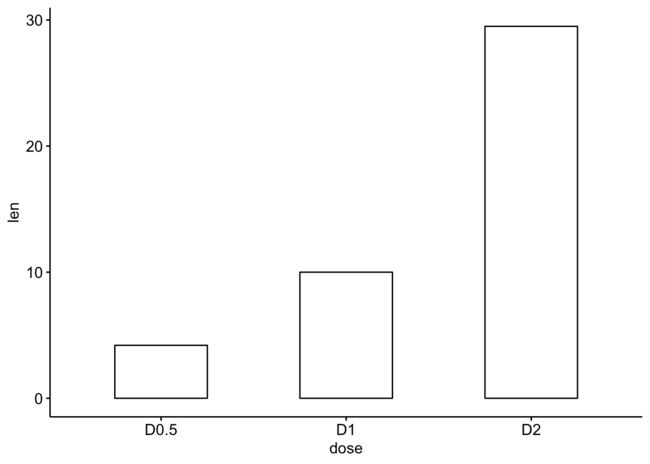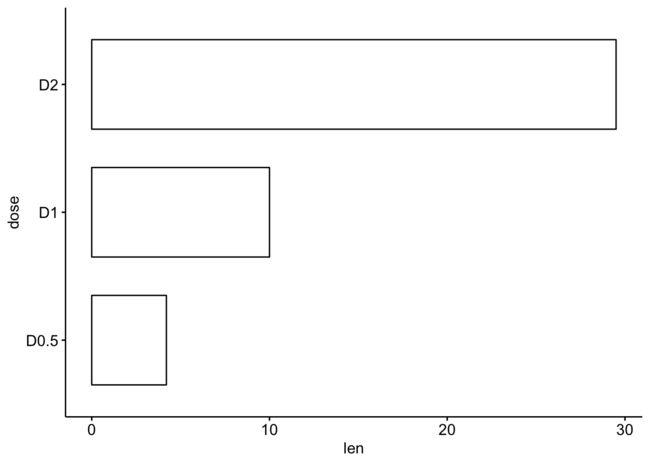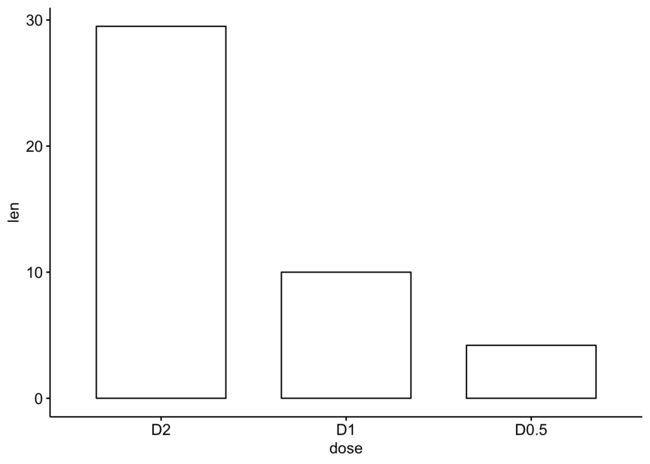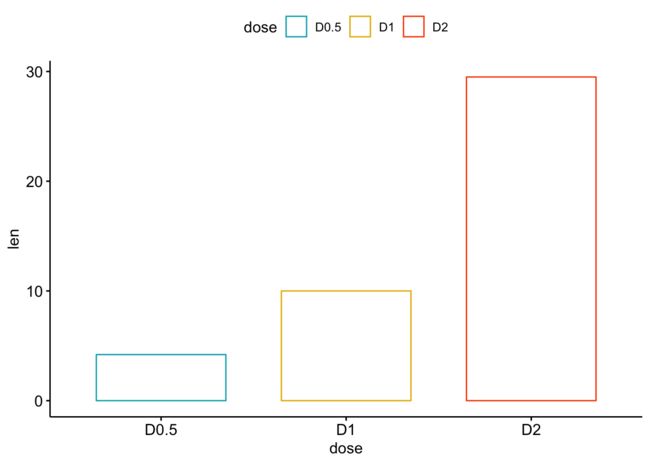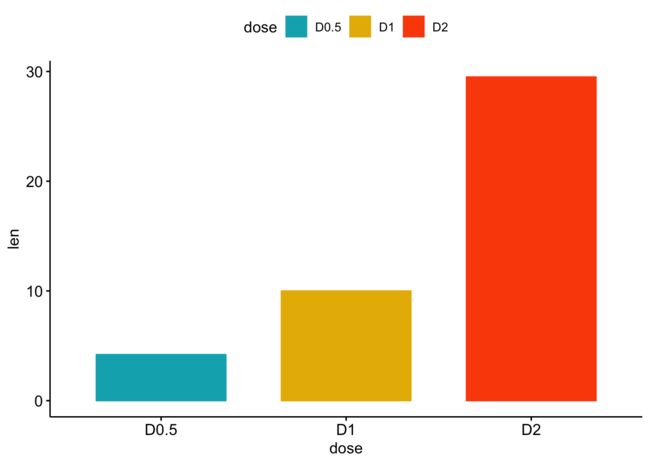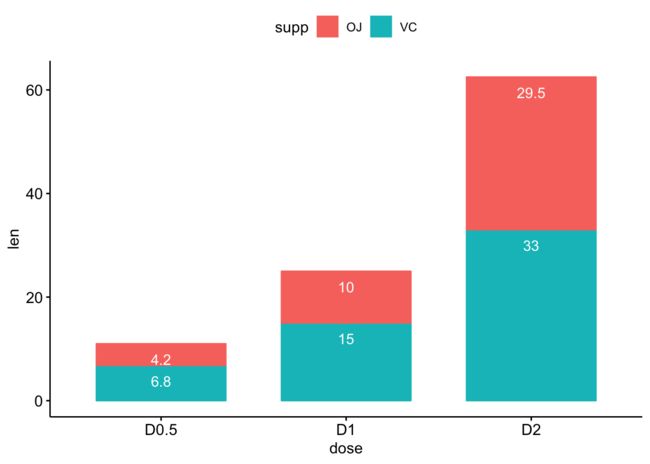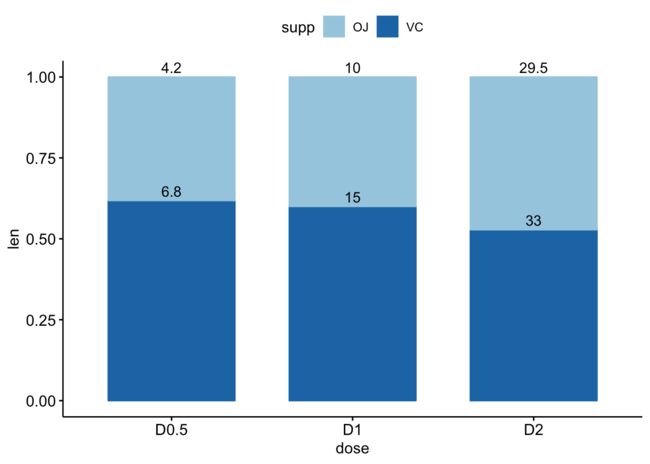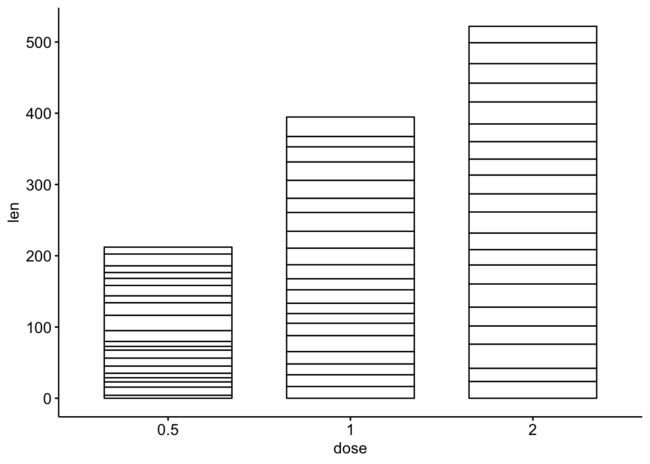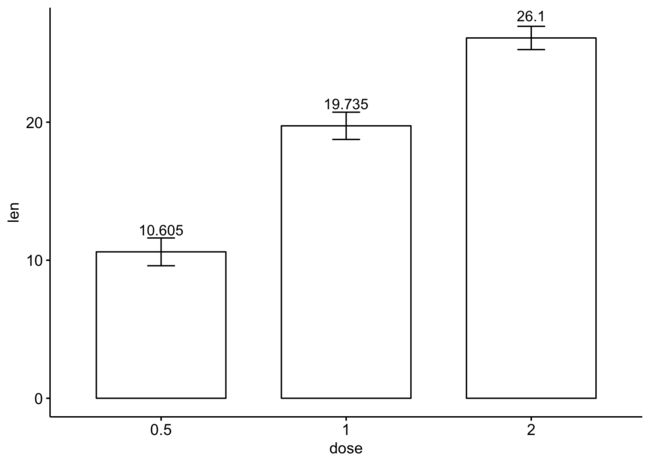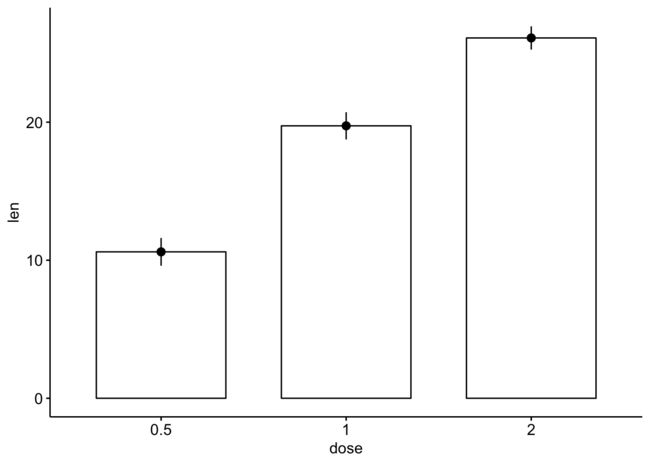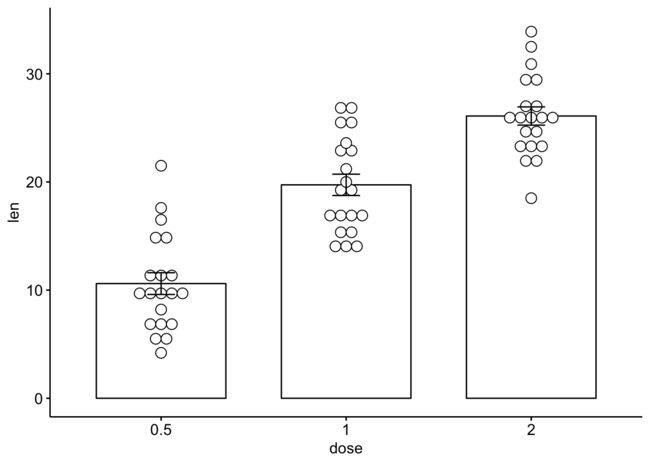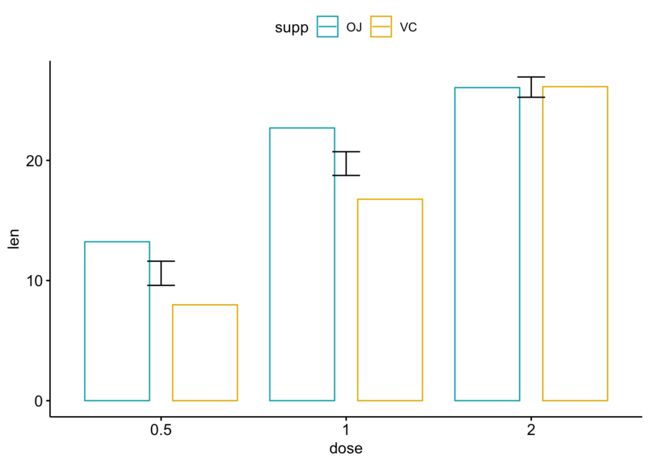使用ggbarplot函数绘制条形图
加载所需R包
library(ggpubr)
基本用法:
Usage
ggbarplot(data, x, y, combine = FALSE, merge = FALSE, color = "black",
fill = "white", palette = NULL, size = NULL, width = NULL,
title = NULL, xlab = NULL, ylab = NULL, facet.by = NULL,
panel.labs = NULL, short.panel.labs = TRUE, select = NULL,
remove = NULL, order = NULL, add = "none", add.params = list(),
error.plot = "errorbar", label = FALSE, lab.col = "black",
lab.size = 4, lab.pos = c("out", "in"), lab.vjust = NULL,
lab.hjust = NULL, sort.val = c("none", "desc", "asc"),
sort.by.groups = TRUE, top = Inf, position = position_stack(),
ggtheme = theme_pubr(), ...)
常用参数:
Arguments
data #a data frame
x, y #x and y variables for drawing.
combine #logical value. Default is FALSE. Used only when y is a vector containing multiple variables to plot. If TRUE, create a multi-panel plot by combining the plot of y variables.
merge #logical or character value. Default is FALSE. Used only when y is a vector containing multiple variables to plot. If TRUE, merge multiple y variables in the same plotting area. Allowed values include also "asis" (TRUE) and "flip". If merge = "flip", then y variables are used as x tick labels and the x variable is used as grouping variable.
color, fill #outline and fill colors.
palette #the color palette to be used for coloring or filling by groups. Allowed values include "grey" for grey color palettes; brewer palettes e.g. "RdBu", "Blues", ...; or custom color palette e.g. c("blue", "red"); and scientific journal palettes from ggsci R package, e.g.: "npg", "aaas", "lancet", "jco", "ucscgb", "uchicago", "simpsons" and "rickandmorty".
size #Numeric value (e.g.: size = 1). change the size of points and outlines.
width #numeric value between 0 and 1 specifying box width.
title #plot main title.
xlab #character vector specifying x axis labels. Use xlab = FALSE to hide xlab.
ylab #character vector specifying y axis labels. Use ylab = FALSE to hide ylab.
facet.by #character vector, of length 1 or 2, specifying grouping variables for faceting the plot into multiple panels. Should be in the data.
panel.labs #a list of one or two character vectors to modify facet panel labels. For example, panel.labs = list(sex = c("Male", "Female")) specifies the labels for the "sex" variable. For two grouping variables, you can use for example panel.labs = list(sex = c("Male", "Female"), rx = c("Obs", "Lev", "Lev2") ).
short.panel.labs #logical value. Default is TRUE. If TRUE, create short labels for panels by omitting variable names; in other words panels will be labelled only by variable grouping levels.
select #character vector specifying which items to display.
remove #character vector specifying which items to remove from the plot.
order #character vector specifying the order of items.
add #character vector for adding another plot element (e.g.: dot plot or error bars). Allowed values are one or the combination of: "none", "dotplot", "jitter", "boxplot", "point", "mean", "mean_se", "mean_sd", "mean_ci", "mean_range", "median", "median_iqr", "median_mad", "median_range"; see ?desc_statby for more details.
add.params #parameters (color, shape, size, fill, linetype) for the argument 'add'; e.g.: add.params = list(color = "red").
error.plot #plot type used to visualize error. Allowed values are one of c("pointrange", "linerange", "crossbar", "errorbar", "upper_errorbar", "lower_errorbar", "upper_pointrange", "lower_pointrange", "upper_linerange", "lower_linerange"). Default value is "pointrange" or "errorbar". Used only when add != "none" and add contains one "mean_*" or "med_*" where "*" = sd, se, ....
label #specify whether to add labels on the bar plot. Allowed values are: logical value: If TRUE, y values is added as labels on the bar plot; character vector: Used as text labels; must be the same length as y.
lab.col, lab.size #text color and size for labels.
lab.pos #character specifying the position for labels. Allowed values are "out" (for outside) or "in" (for inside). Ignored when lab.vjust != NULL.
lab.vjust #numeric, vertical justification of labels. Provide negative value (e.g.: -0.4) to put labels outside the bars or positive value to put labels inside (e.g.: 2).
lab.hjust #numeric, horizontal justification of labels.
sort.val #a string specifying whether the value should be sorted. Allowed values are "none" (no sorting), "asc" (for ascending) or "desc" (for descending).
sort.by.groups #logical value. If TRUE the data are sorted by groups. Used only when sort.val != "none".
top #a numeric value specifying the number of top elements to be shown.
position #设置排列方式 Position adjustment, either as a string, or the result of a call to a position adjustment function.
ggtheme #function, ggplot2 theme name. Default value is theme_pubr(). Allowed values include ggplot2 official themes: theme_gray(), theme_bw(), theme_minimal(), theme_classic(), theme_void(),
... #other arguments to be passed to be passed to ggpar().
使用示例:
Examples
# Data
df <- data.frame(dose=c("D0.5", "D1", "D2"),
len=c(4.2, 10, 29.5))
print(df)
## dose len
## 1 D0.5 4.2
## 2 D1 10.0
## 3 D2 29.5
# Basic plot with label outsite 添加标量y的值作为标签
p1 <- ggbarplot(df, x = "dose", y = "len",
label = TRUE, label.pos = "out")
p1
# Change width 更改柱子的宽度
p2 <- ggbarplot(df, x = "dose", y = "len", width = 0.5)
p2
# Change the plot orientation: horizontal 变换坐标轴的方向
p3 <- ggbarplot(df, "dose", "len", orientation = "horiz")
p3
# Change the default order of items 设定指定的排列顺序
p4 <- ggbarplot(df, "dose", "len",
order = c("D2", "D1", "D0.5"))
p4
# Change colors 更改填充色和边框色
# Change fill and outline color
# add labels inside bars
p5 <- ggbarplot(df, "dose", "len",
fill = "steelblue", color = "black",
label = TRUE, lab.pos = "in", lab.col = "white")
p5
# Change colors by groups: dose
# Use custom color palette
p6 <- ggbarplot(df, "dose", "len", color = "dose",
palette = c("#00AFBB", "#E7B800", "#FC4E07"))
p6
# Change fill and outline colors by groups
p7 <- ggbarplot(df, "dose", "len",
fill = "dose", color = "dose",
palette = c("#00AFBB", "#E7B800", "#FC4E07"))
p7
# Plot with multiple groups 分组绘图
# Create some data
df2 <- data.frame(supp=rep(c("VC", "OJ"), each=3),
dose=rep(c("D0.5", "D1", "D2"),2),
len=c(6.8, 15, 33, 4.2, 10, 29.5))
print(df2)
## supp dose len
## 1 VC D0.5 6.8
## 2 VC D1 15.0
## 3 VC D2 33.0
## 4 OJ D0.5 4.2
## 5 OJ D1 10.0
## 6 OJ D2 29.5
# Plot "len" by "dose" and change color by a second group: "supp"
# Add labels inside bars
p8 <- ggbarplot(df2, "dose", "len",
fill = "supp", color = "supp",
label = TRUE, lab.col = "white", lab.pos = "in")
p8
# Change position: Interleaved (dodged) bar plot 更改排列方式
p9 <- ggbarplot(df2, "dose", "len",
fill = "supp", color = "supp", palette = "Paired",
label = TRUE,
position = position_dodge())
p9
p10 <- ggbarplot(df2, "dose", "len",
fill = "supp", color = "supp", palette = "Paired",
label = TRUE,
position = position_fill())
p10
# Add points and errors
# Data: ToothGrowth data set we'll be used.
df3 <- ToothGrowth
head(df3, 10)
## len supp dose
## 1 4.2 VC 0.5
## 2 11.5 VC 0.5
## 3 7.3 VC 0.5
## 4 5.8 VC 0.5
## 5 6.4 VC 0.5
## 6 10.0 VC 0.5
## 7 11.2 VC 0.5
## 8 11.2 VC 0.5
## 9 5.2 VC 0.5
## 10 7.0 VC 0.5
# It can be seen that for each group we have
# different values
p11 <- ggbarplot(df3, x = "dose", y = "len")
p11
# Visualize the mean of each group
p12 <- ggbarplot(df3, x = "dose", y = "len",
add = "mean")
p12
# Add error bars: mean_se 添加不同类型的误差棒
# (other values include: mean_sd, mean_ci, median_iqr, ....)
# Add labels
p13 <- ggbarplot(df3, x = "dose", y = "len",
add = "mean_se", label = TRUE, lab.vjust = -1.6)
p13
# Use only "upper_errorbar"
p14 <- ggbarplot(df3, x = "dose", y = "len",
add = "mean_se", error.plot = "upper_errorbar")
p14
# Change error.plot to "pointrange"
p15 <- ggbarplot(df3, x = "dose", y = "len",
add = "mean_se", error.plot = "pointrange")
p15
# Add jitter points and errors (mean_se)
p16 <- ggbarplot(df3, x = "dose", y = "len",
add = c("mean_se", "jitter"))
p16
# Add dot and errors (mean_se)
p17 <- ggbarplot(df3, x = "dose", y = "len",
add = c("mean_se", "dotplot"))
p17
# Multiple groups with error bars and jitter point
p18 <- ggbarplot(df3, x = "dose", y = "len", color = "supp",
add = "mean_se", palette = c("#00AFBB", "#E7B800"),
position = position_dodge())
p18
参考来源:
https://www.rdocumentation.org/packages/ggpubr/versions/0.1.4/topics/ggbarplot
sessionInfo()
## R version 3.5.1 (2018-07-02)
## Platform: x86_64-apple-darwin15.6.0 (64-bit)
## Running under: OS X El Capitan 10.11.3
##
## Matrix products: default
## BLAS: /Library/Frameworks/R.framework/Versions/3.5/Resources/lib/libRblas.0.dylib
## LAPACK: /Library/Frameworks/R.framework/Versions/3.5/Resources/lib/libRlapack.dylib
##
## locale:
## [1] zh_CN.UTF-8/zh_CN.UTF-8/zh_CN.UTF-8/C/zh_CN.UTF-8/zh_CN.UTF-8
##
## attached base packages:
## [1] stats graphics grDevices utils datasets methods base
##
## other attached packages:
## [1] bindrcpp_0.2.2 ggpubr_0.1.7.999 magrittr_1.5 ggplot2_3.0.0
##
## loaded via a namespace (and not attached):
## [1] Rcpp_0.12.18 rstudioapi_0.7 bindr_0.1.1
## [4] knitr_1.20 tidyselect_0.2.4 munsell_0.5.0
## [7] colorspace_1.3-2 R6_2.2.2 rlang_0.2.2
## [10] stringr_1.3.1 plyr_1.8.4 dplyr_0.7.6
## [13] tools_3.5.1 grid_3.5.1 gtable_0.2.0
## [16] withr_2.1.2 htmltools_0.3.6 assertthat_0.2.0
## [19] yaml_2.2.0 lazyeval_0.2.1 rprojroot_1.3-2
## [22] digest_0.6.16 tibble_1.4.2 crayon_1.3.4
## [25] RColorBrewer_1.1-2 purrr_0.2.5 glue_1.3.0
## [28] evaluate_0.11 rmarkdown_1.10 labeling_0.3
## [31] stringi_1.2.4 compiler_3.5.1 pillar_1.3.0
## [34] scales_1.0.0 backports_1.1.2 pkgconfig_2.0.2
